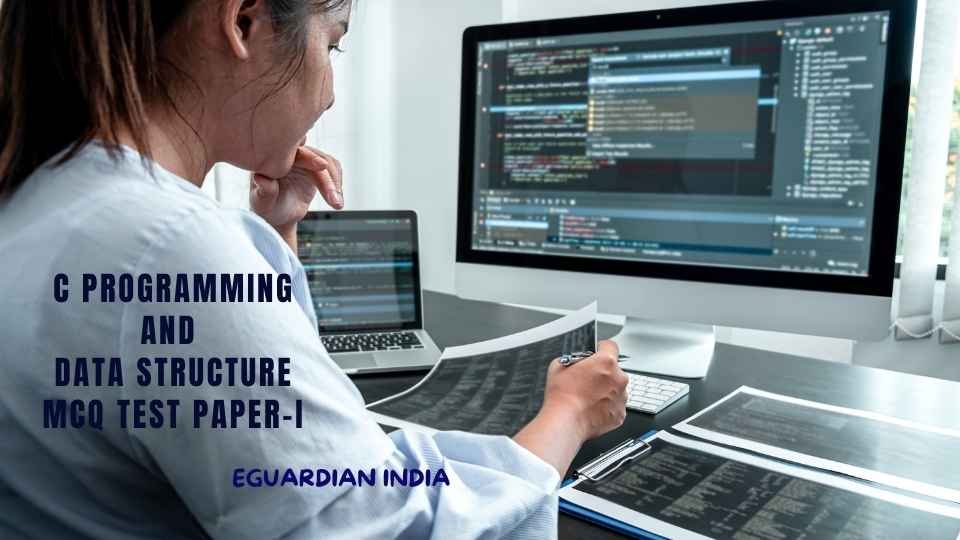In this MCQ Quiz, we will be providing you with MCQs on a variety of discrete topics. So, if you are looking for a good way to brush up on your discrete mathematics skills, then this is the article for you!
1. The aim of this article is to provide you with MCQ questions and answers for the topic of discrete mathematics.
2. If you are looking for a challenging quiz on discrete mathematics, then you have come to the right place!
3. Some of the questions in this quiz may be new to you, while others may be more familiar.

Brief Introduction to Discrete Mathematics
Discrete mathematics refers to a branch of mathematics that deals with the properties of finite and discrete objects. These objects can be numbers, sets, vectors, matrices, or logical propositions.
Discrete mathematics is used in fields such as computer science, engineering, and physics. It is also used in business to solve problems such as inventory management and financial analysis.
Discrete Mathematics MCQs with Answers
1. The theory of sets was developed by German mathematician ___
a. George Cantor
b. George Bool
c. George Herbert
d. George Crayon
Answer: a. George Cantor
2. The two methods of representing a set are:
a. Roster and Tabular
b. Roster and Set Builder
c. Array and Tabular
d. None of the above
Answer: b. Roster and Set Builder
3. The set of all positive integers whose cube is odd –
a. {2k+1: k≥0, k is an integer}
b. {2k+1: k≥n, n is an integer}
c. {2k+2: k≥0, k is an integer}
d. None of the above
Answer: a. {2k+1: k≥0, k is an integer}
4. Set {x:x is a positive integer and x²<40} in the roster form is —
a. {1, 4, 5, 6, 7, 8, 9}
b. {1, 2, 3, 4, 5, 6}
c. {1, 3, 4, 5, 7, 8}
d. {1, 2, 3, 4, 5, 6}
Answer: b. {1, 2, 3, 4, 5, 6}
(For Ques 1 to 8) For the following sets : Ø, A = {1,3 }, B = {1, 5, 9}, C = {1, 3, 5, 7, 9}, insert the correct symbol between
5. Ø — B
a. =
b. ⊂
c. ⊄
d. ∈
Answer: b. ⊂
6. A — B
a. =
b. ⊂
c. ⊄
d. ∈
Answer: c. ⊄
7. A—C
a. =
b. ⊂
c. ⊄
d. ∈
Answer: b. ⊂
8. B—C
a. =
b. ⊂
c. ⊄
d. ∈
Answer: b. ⊂
9. Let U = {1, 2, 3, 4, 5, 6, 7, 8, 9, 10}and A = {1, 3, 5, 7, 9}. Then A’ is —
a. {2, 4, 6, 8, 10}
b. {1, 2, 3, 6}
c. {2, 6}
d. {1, 4, 5, 6, 7, 8}
Answer: a. {2, 4, 6, 8, 10}
10. Let A = {2, 4, 6, 8} and B = {6, 8, 10, 12}. Then A∪B is—
a. {2, 5, 6, 10}
b. {2, 4, 6, 8, 10, 12}
c. {2, 4, 6, 8}
d. {2, 8, 10, 12}
Answer: b. {2, 4, 6, 8, 10, 12}
11. If A = {a, e, i, o, u} and B = {a, i, u} then which is true
a. A∪B = A
b. A∩B = A
c. A⊂B
d. B⊆A
Answer: a. A∪B = A
12. If x and y are two sets such that n(x∪y) = 50, n(x) =28 and n(y) = 32, find n(x∩y)
a. 10
b. 20
c. 30
d. 40
Answer: a. 10
13. A statement is said to be a ___ if it is true for all logical possibilities.
a. theorem
b. tautology
c. anatomy
d. clause
Answer: b. tautology
The angles of a triangle are in the ratio 2:3:5 find them—
14. In radians
a. π/5, 2π/3, π/3
b. π/5, 3π/10, π/2
c. 3π/3, 2π/4, π/7
d. 2π/4, 4π/3, π/7
Answer: b. π/5, 3π/10, π/2
15. In degree
a. 30º, 40º, 50º
b. 36º, 54º, 90º
c. 40º, 30º, 120º
d. 20º, 40º, 50º
Answer: b. 36º, 54º, 90º
16. If two simple statements p and q are connected by the world ‘and’ then the resulting compound statement “p and q” is called a ___.
a. conjunction
b. disjunction
c. set
d. complement
Answer: a. conjunction
17. Chose the negation of the statement
p: New Delhi is a city.
a. ∼ p: New Delhi is a city
b. ∼ p: New Delhi is not a city
c. ∼ p: It is the case that New Delhi is a city
d. ∼ p: It is true that New Delhi is a city
Answer: b. ∼ p: New Delhi is not a city
18. Which is the negation of the following conjunction–
Paris is in France and London is in England
a. ∼ p: Paris is not in France, and ∼ q: London is not in England.
b. ∼ p∧q: Paris is not in France or London is not in England
c. ∼ p∧q: Paris is in France and London is not in England
d. ∼ p∧q: Paris is not in France or London is in England
Answer: b. ∼ p∧q: Paris is not in France or London is not in England
19. Which is the negation of the following conjunctions:-
2+3 = 5 and 8<10.
a. ~ p: 2+3 = 5 and q: 8<10.
b. ~ p: 2+3 =5 and q: 8 =10
c. ~ p∧q = 2+3 ≠ 5 or (8<10)
d. ~ p∧q = 2+3 ≠ 5 and (8<10)
Answer: c. ~ p∧q = 2+3 ≠ 5 or (8<10)
20. If a and b are any two elements of a group G, then the equations ax = b and ya = ___ have unique solutions in G.
a. b
b. a
c. a & b
d. y
Answer: a. b
21. If every element of a group G is its own inverse then G is ___
a. Unique
b. Same
c. Abelian
d. Alone
Answer: c. Abelian
22. Radian is constant angle and π = ___
a. 270º
b. 360º
c. 170º
d. 180º
Answer: d. 180º
23. θ = s/___
a. r
b. l
c. k
d. m
Answer: a. r
24. (Sinθ + Cosecθ)² + (Cosθ + Secθ)² = 7+ tan²θ + ___
a. Sec² θ
b. Cot² θ
c. Cosec² θ
d. Cos² θ
Answer: b. Cot² θ
25. (tanθ + secθ – 1)/ (tanθ – secθ +1) = (1+sinθ)/___
a. cosθ
b. sinθ
c. secθ
d. tanθ
Answer: a. cosθ
26. sec 30° tan 60° + sin 45° cosec45° + cos 30° cot 60° = ___
a. 6/7
b. 2/9
c. 7/2
d. 0
Answer: c. 7/2
27. If f(x) = logX, X>0 then f’(X) = ___
a. ½
b. 2/3
c. 1/x
d. 1/5
Answer: c. 1/x
28. If f(x) = cos x then f’(x) = ___
a. – sin x
b. – tan x
c. – sec x
d. – cot x
Answer: a. – sin x
29. sec (45° + A) sec [90° – (45° + A)] = ___
a. 2 cosec 2A
b. 3 sec 2A
c. 2 sec 2A
d. 0
Answer: c. 2 sec 2A
30. If y = secx then dy/dx is ___
a. secx tanx
b. cosecx secx
c. sinx cosx
d. tanx cotx
Answer: a. secx tanx
31. If sinθ = √3/2, cosθ = ½ thenθ = ___
a. π/4
b. π/5
c. π/2
d. π/3
Answer: d. π/3
32. If sinθ = -√3/2, cosθ = -1/2 thenθ = -2π/3
a. π/3
b. -2π/3
c. -π/3
d. -4π/3
Answer: b. -2π/3
33. ∫ sin 10x sin 2x dx = ___
a. (sin x)/x – ½ (sin 2x)/4 + c
b. (sin 8x)/x – ½ (sin 12x)/24 + c
c. (sin 2x)/x – ½ (sin x)/4 + c
d. (sin 8x)/x + ½ (sin 12x)/24 + c
Answer: b. (sin 8x)/x – ½ (sin 12x)/24 + c
34. ∫ sec² (7-4x)dx = ___
a. –tan (7-4x)/4 + c
b. –tan (7-4x) + c
c. tan (7-4x)/4 + c
d. –tan (7+x)/4 + c
Answer: a. –tan (7-4x)/4 + c
35. ∫ (sin√x)/ √x = ___
a. –2cos√x + c
b. 2cos√x + c
c. -sin√x + c
d. sin√x
Answer: a. –2cos√x + c
36. ∫ secx dx = ___
a. log(secx + cotx)dx
b. log(secx + tanx)dx
c. log(secx + cosecx)dx
d. log(secx + cosx)dx
Answer: b. log(secx + tanx)dx
37. ∫ (x+4)/(6x – 7 – x²)dx = ___
a. – ½ log(6x – 7 – x²) +(7/2√2)log(√2 + x – 3)/(√2 – x ) + c
b. – ½ log(6x ) +(7/2√2)log(√2 + x – 3)/(√2 – x + 3) + c
c. – ½ log(6x – 7 – x²) +(7/2√2)log(√2 + x – 3)/(√2 – x + 3) + c
d. ½ log(6x – x²) +(7/2√2)log(√2 + x – 3)/(√2 – x + 3) + c
Answer: c. – ½ log(6x – 7 – x²) +(7/2√2)log(√2 + x – 3)/(√2 – x + 3) + c
38. ∫(a² + x²)dx = ___
a. log(x+√(x² + a²) + x√(a² + x²) + c
b. a²/2log(x+√(x² + a²) + x√(a² + x²)/2 + c
c. a²log(x+√(x² + a²) + √(a² + x²)/2 + c
d. a²/2log(x-√(x² + a²) – x√(a² + x²)/2 + c
Answer: b. a²/2log(x+√(x² + a²) + x√(a² + x²)/2 + c
39. If x+iy = √(a+ib)/(c+id) then (x² + y²)² = ___
a. (a²+b²)/(c²)
b. (a²+b²)/(d²)
c. (a²+b²)
d. (a²+b²)/(c²+d²)
Answer: d. (a²+b²)/(c²+d²)
40. ∫ dx/(3x² + 13x –10) = ___
a. 1/17log(3x – 2)/3 + c
b. log(3x – 2)/(x + 5) + c
c. 1/17log(3x – 2)/3(x + 5) + c
d. 1/17log(3x – 2)/(x + 5) + c
Answer: c. 1/17log(3x – 2)/3(x + 5) + c
41. Which of the following are true?
a. The identity element in a group is unique.
b. In a group G the inverse of an element is unique.
c. Closure: For every a, b ∈ G, a * b ∈ G
d. Associative: For every a, b, c ∈ G, a * (b *c) = (a * b) * c
e. If a and b are any two elements of a group G, then the equations ax = b and ya = b have many solutions.
i. a, b, c, e
ii. a, b, c, d
iii. a, c, e
iv. none of these
Answer: ii. a, b, c, d
42. Which are true?
a. sin²x + cos²x = 1
b. 1+ tan²x = sec²x
c. 1-cos²x = cosec²x
d. 1 + cot²x = cosec²x
e. 1-cos²x = sin²x
i. a, c, e
ii. b, c, d
iii. a, b, d, e
iv. none of the above
Answer: iii. a, b, d, e
43. (tanx + secx – 1)/(tanx – secx +1) = ___
a. cosx/(1-sinx)
b. sinx/(1-sinx)
c. tanx/(1+cosx)
d. cosx/(1-tanx)
Answer: a. cosx/(1-sinx)
44. The value of x for which ((3x + 1), 2) =(7,2)
a. 5
b. 3
c. 2
d. None of the above
Answer: c. 2
45. If x = acos²t + bsin²t then (x – a)(x – b) = ___
a. sin²t cos²t
b. (a – b) ² sin²t
c. (a – b) ² sin²t cos²t
d. (a – b) ²cos²t
Answer: c. (a – b) ² sin²t cos²t
46. (1- sinA + cosA)² = ___
a. (1+cosA)
b. 2(1-sinA)(1+cosA)
c. (1-sinA)(1+cosA)
d. 2(1-sinA)(1-cosA)
Answer: b. 2(1-sinA)(1+cosA)
47. ∫ x sin² xdx = ___
a. ¼(x² – x sin 2x )
b. ¼(x² + x sin 2x – cos2x) + c
c. ¼(x² – x sin 2x – (cos2x)/2) + c
d. (x² – x sin 2x – (cos2x)/2) + c
Answer: c. ¼(x² – x sin 2x – (cos2x)/2) + c
48. For applied mathematics, the study of the differential equation consists of ___
a. Formation of the differential equation from the given problem.
b. Solution of the differential equation, evaluating the arbitrary constants from the given condition.
c. The degree of a differential equation is the degree of the highest derivative appearing in it.
d. Physical preparation of the solution.
e. Problems in the oscillation of mechanical, electrical systems, bending of beams.
i. a, b, e
ii. a, c, e
iii. a, b, d
iv. none
Answer: iii. a, b, d
49. If tanα = 1/3 and tanβ = 1/7 then 2α + β = ___
a. π/2
b. π/4
c. π/5
d. π/6
Answer: b. π/4
50. If tan(x/2) = t then cosx = ___
a. (1- t²)/( t²)
b. (1 + t²)
c. (1- t²)/(1 + t²)
d. (1- t²)
Answer: c. (1- t²)/(1 + t²)
You may read more MCQs of DM from here
You may download the pdf file form
Conclusion
The quiz was a helpful way to test your knowledge of discrete mathematics. If you have any questions, be sure to ask a math teacher or tutor. Happy studying! Please share it on social media with friends and family members.
Practice More Quiz
- Distributed Systems MCQs
- Digital Image Processing MCQs
- Software Engineering MCQs pdf
- Discrete Mathematics MCQs: Set-2



